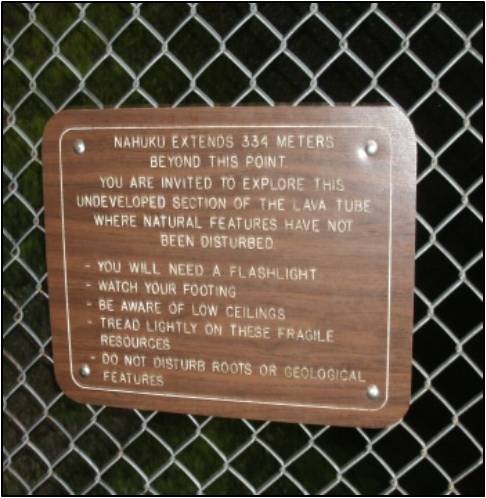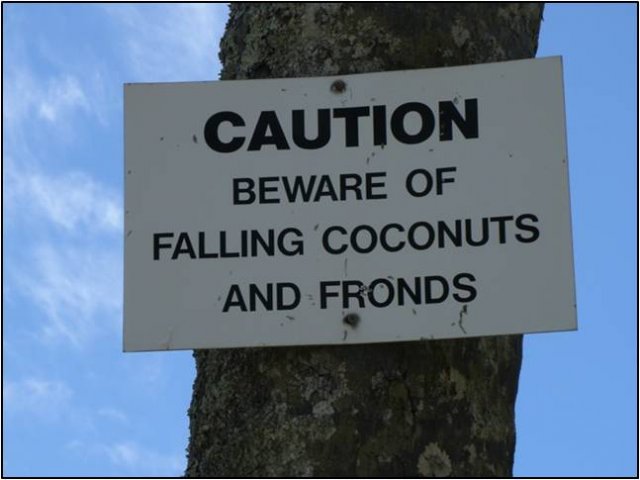This morning I was deep in prayer, as I often am, for our grandchildren. (Read the rest of this post before you think that sounds oh-so-spiritual.) Because our side of the family has contributed a tendency for nearsightedness to their gene pool, one of my requests was that their eyes continue to be clear and sharp and healthy.
So far, so good.
“But what about their ears?” I suddenly thought, remembering our nephew who has a hearing loss.* So I prayed for their ears.
“But what about their sense of smell?” I once worked with a guy who had lost his as an infant. So I prayed for all of their senses.
It’s never bad to pray, but can you see the death spiral I was falling into? What pitiful faith, and what a horrible view of God, as if he were just waiting to pounce on my mistakes and omissions, like the triumphant victor in a chess match:
“Checkmate! You prayed for his eyes, but neglected his ears, so I think I’ll make him deaf. And while I’m at it, maybe lame as well. And it’s all your fault! When you see him struggling with his little crutch, like Tiny Tim, remember that if you‘d only prayed properly, he would be running joyfully over the hill!”
Pitiful. Blasphemous, really.
That God wants us to pray—with specific requests, for occasions of enormous important and for the most trivial desires of our hearts—is undoubtedly true. That our prayers really matter in the working out of the details of the universe is also true, if somewhat incomprehensible.
Our prayers really matter, but they don’t limit God, nor are they necessary for his work. If we neglect a detail, he is not going to ignore what we meant in favor of what we actually said, or didn’t say. We do not need to micromanage God.
You must not imagine that the result depends on you. The question, as far as you are concerned, is whether you are to be honoured in having a hand in the work that God is doing, and will do, whether you help him or not. It shows no faith in God to make frantic efforts or frantic lamentations. — George MacDonald, Robert Falconer
*I suppose this is not the place for a joke about how this affliction especially qualifies him for his successful avocation of rock star.
Permalink | Read 2732 times | Comments (0)
Category Random Musings: [first] [previous] [next] [newest]
(Continued from Day 6)
This was our final day in Hawaii, and we checked out of the lovely Hilton Waikoloa Village after enjoying its amenities a bit more. I don’t think I mentioned that they have quite an impressive collection of artwork.
Our plane did not leave until nearly 9 o’clock at night, however, so we once again ventured south, to catch some sights we passed by on our return from Volcanoes National Park.
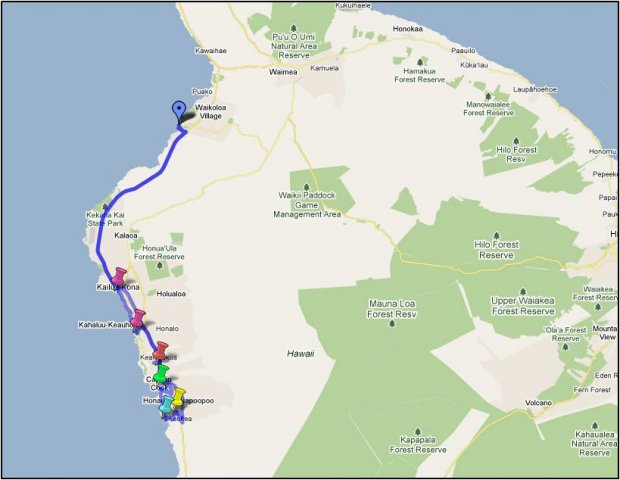
Click on the map for more detail. You will be able to zoom in and out, and move around.
At Kailua Kona (where the Walmart is) we diverted from Route 11 to take in the sights along Ali’I Drive, which hugs the coast (between the pink pins on the map). From there we found our way to Kealakekua Bay State Historical Park (green pin). There we explored another heiau, not that we were seeking out places of human sacrifice, you understand. Both heiaus had this puzzling warning sign:
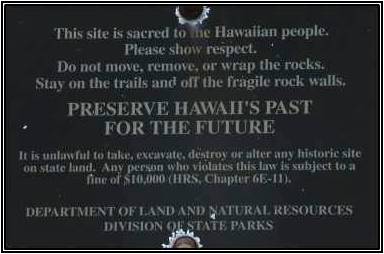
I mean, I get the part about not damaging the structure, or stealing rocks for souvenirs. But don’t wrap the rocks? What’s with that? (More)
(Continued from Day 5)
This morning we arose early, broke out our snorkeling gear, and headed for the resort’s lagoon. The lagoon is manmade, but open to the sea, so if you get there before there’s a lot of splashing around you can see some interesting fish and sea turtles.
That done, we were on the road again, this time going to the Kohala area, the northwestern tip of the island.
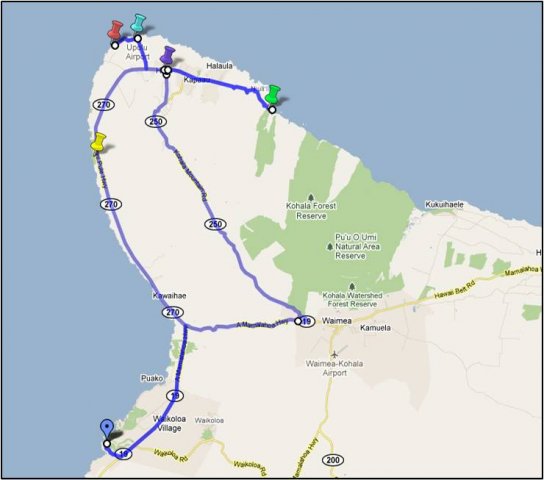
Click on the map for more detail. You will be able to zoom in and out, and move around.
Polulu Beach (green marker on the map) is reached by foot, via a steep trail that begins with these warning signs.
(Continued from Day 4, Part 2)
At 8:00 this morning we had the mandatory timeshare presentation that made the whole trip possible. Despite having many, many opportunities in Florida to earn stuff by wasting time in this way, we had never taken advantage of them, and this was our first.
Based on the experiences of others, we expected a boring group presentation and a high-pressure sales pitch. I even brought a book to read, as I was told that is the best way of getting through the presentation.
Not here. First, the presentation was personal, just the agent and us. Surprisingly, that was not boring at all. I survived very well the insistent personal questions—designed to help her tailor her presentation to our personalities—by reminding myself that there was a person behind that sales front, and countering every question with one back at her. “How many children do you have?” she’d ask; “Two; how about you?” I’d respond. We actually had an interesting conversation, instead of me just resenting being asked questions I didn’t want to answer.
The presentation was followed by a tour of the Hilton timeshare properties at Waikoloa Village. (We were staying in their hotel, not a timeshare.) Again, it was just the two of us and our guide.
At the end, we were given the opportunity to buy into the program, and—as we had expected—some incentives to “do it now.” But really, there was little pressure; they expect the program to sell itself.
And if we had been different people, it would have. Timeshares aren’t the burdens they were many years ago, at least not these. If our travelling tastes ran to staying in major cities and tourist destinations, this would be an excellent resource. Hilton has a vast array of properties, from small apartments to major hotels, available for their community members to use on “points” generated by their timeshare properties. Some are more luxurious than others, but all are backed by Hilton quality. The system could save someone who vacations like that a lot of money over time.
But that’s not us. True, we’ve learned to enjoy a nice hotel on the company’s dime dollar. We also stopped patronizing cheap motels when the clientele went from frugal to sleazy, at least along I-95. I’m talking bedbug / appalling personal hygiene / meth residue on the walls kind of sleazy. We like good quality accommodations. But our travel largely revolves around family and friends—the sales rep reluctantly informed us that they have as yet no properties in the Gambia—and we’d rather not have HD TV in the room and a golf course and tennis courts nearby.
So, they didn’t make a sale, but succeeded in proving to us that timeshare programs are like I-95 hotels: you can find a good one if you’re careful.
All in all, considering the value we received, I call it two and a half hours well spent.
It was our fifth day in Hawaii, and we hadn’t yet been swimming. So we headed just a bit north, to Hapuna Beach State Park, which has won numerous accolades for its white-sand beach.
The sand was nice, the water was nice—albeit a bit too calm for my taste—and we spent a pleasant couple of hours there—but it is hard not to be a Florida snob when it comes to sand, surf, and sun.
Back at the resort, we prepared for the evening’s big event, the Legends of the Pacific luau. Big, all-you-can-eat spread of Hawaiian food. Entertainment featuring Polynesian music and dance. Not something that would have drawn us with its $100/person price tag, but for what we paid (it was part of our package), it was fun, and good eating.
This short YouTube video by Westjet gives you a view of the Hilton Waikoloa resort, and you’ll see part of the luau production in the middle. I know some grandkids who would have enjoyed the fire dancer.
Historical note: One of our table-neighbors was playing with his iPad while waiting for dinner to be ready, while his wife nagged him to get rid of it. I sympathized with him, but he put it away and did not share with us what he had been reading—that halfway across the world, Osama bin Laden had been killed.
(Continued from Day 4, Part 1)
After climbing up out of the Kilauea Iki crater, our next adventure was at the Thurston Lava Tube.
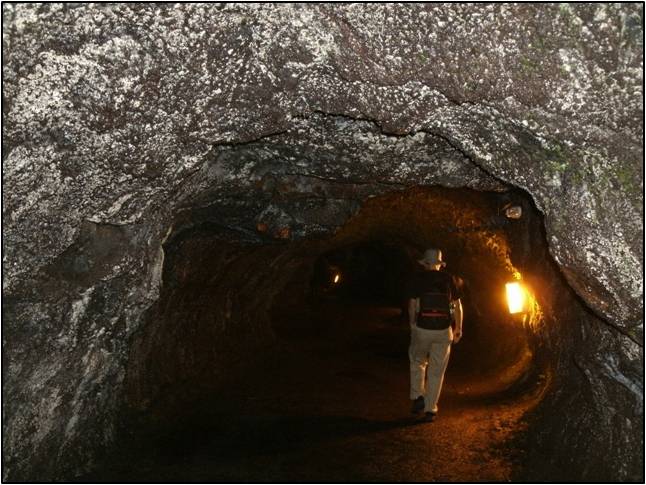
Walking inside a cave made by flowing lava was impressive enough, but the real fun began after this sign:
Just after midnight today, Steven Perezluha reached Annapolis, Maryland as the ninth bicyclist in his division to complete the Race Across AMerica. With the 41-minute credit he received for a tornado-caused delay in Kansas, his official finish was at 11:34 last night. Steven raced from the Pacific to the Atlantic in an even ten days and eight hours.
Congratulations to Steven!
And because no one, least of all a major athlete, succeeds without a great deal of help:
Congratulations to his sponsors, his incredible support crew, and his parents!
Permalink | Read 2512 times | Comments (0)
Category Everyday Life: [first] [previous] [next] [newest] Just for Fun: [first] [previous] [next] [newest]
No, not our granddaughter. :( But something her siblings would probably like. It brightened my day, and might do so for you while you're waiting for the next Hawaii post.
John Rutter's Look at the World. (H/T SouthForte Farms)
Permalink | Read 2394 times | Comments (1)
Category Just for Fun: [first] [previous] [next] [newest]
The Race Across AMerica may be the craziest bike race ever. From the Pacific to the Atlantic, from Oceanside, California to Annapolis, Maryland (this year's route). The record for the solo men's division is a little over eight days.
Steven Perezluha, the friend of whom I've written before (biking to Alaska, and racing up Pittsburgh's Cathedral of Learning), is making his RAAM debut, his substantial crew led by his uncle, Danny Chew, himself a two-time RAAM winner. From today's VeloNews article:
The youngest rider in the field is 20-year-old Steven Perezluha, nephew of 2-time RAAM winner Danny Chew. “My goal is to finish, hopefully in ten days as the top American finisher,” the youngster declared in Oceanside, “I’m going to try to be conservative at the beginning and not blow up,” he added. Yet it was Perezluha who was first to Time Station 1, 50 miles into the race at Lake Henshaw. In the next 20 miles he was passed by Strasser before reaching the “Glass Elevator,” a fast and winding descent down to the desert floor where temperatures approaching 100 degrees awaited the riders. While it is unknown whether Perezluha did indeed “blow up,” what is certain is that he’s slowed considerably, dropping from being the early leader down to 19th overnight.
Taking it easy, if somewhat oxymoronic to say about such a race, will be the smart thing for Steven to do: there's no percentage in abusing his still-developing body when he has so many more years to hit his peak. But he's such a competitor ... who knows what he might accomplish?
Here are some links if you want to follow his progress:
(added 6/17) Very cool page with animated map and stats, great for following the athletes' progress
Live stream (I include this because it has the potential to be interesting, at least for us, although at the time of writing the stops and starts of video and audio make it too painful to listen to for long.)
Steven's website (hosted by Lime Daley!)
Go, Steven! Finish the race! Do well, but don't overdo it!
Permalink | Read 2440 times | Comments (6)
Category Everyday Life: [first] [previous] [next] [newest]
(Continued from Day 3 - Part 2)
There was nothing about its beginning to presage a day spent amidst reminders of nature’s primordial (and very present) violence.
We awakened early. I grabbed my Bible and a cup of tea, and slipped out to breathe in the morning from our porch. Rarely have I experience such uplifting peace. I bathed in the natural beauty before me—okay, technically it was a golf course, but there were birds, and wind stirring the trees, and no sign of golfers. Best of all was the delight for my ears: I could hear the trilling of unknown Hawaiian birds, the crow of a rooster, and the lowing of a cow. I could hear the breeze, and the soft sounds of Porter puttering in the cottage behind me. More remarkable was what I could not hear: no lawn mowers, no chain saws, no air conditioning compressors, no pool pumps, no airplanes, no construction work, and no road noise—not even a single car. I was awed at how much more conducive to meditation is such a setting.
Somewhat reluctantly, we packed up and headed for breakfast (included with the room) at the Kilauea Lodge restaurant. The feature was French toast: three pieces of Portuguese sweet bread (note: not sweetbreads), each different—plain, taro, and guava—all delicious. It was served with two syrups, maple and coconut. This being Hawaii, not Vermont, the “maple” syrup was not the genuine article, but Porter liked the coconut, and I found the French toast sweet, flavorful, and delicious just as it was.
If forced to name the high point of our trip, I would have to say the helicopter ride on Day 2. No pun intended. Really. But Volcanoes National Park was a close second. Florida has resorts. Florida has botanical gardens. Florida has beaches. Very nice beaches, with surfing, and snorkeling. Florida even has cattle ranches. But Florida has no volcanoes. Not one. Walking across a crater is one amazing experience. Not at all like walking across a Florida parking lot in August. Well, only a little like that. (More)
No, this is not the next installment in the tale of our Hawaiian vacation, although it will help explain why that wasn't published yesterday.
Our refrigerator was well over 10 years old. It was bought used in 2001, and I have no idea of its history. It wasn’t in very great shape then, though somehow it worked quite well for us. For years Porter would periodically grumble that it was an energy hog, reminding me that it couldn’t last forever, and wouldn’t it be better not to have to replace it on an emergency basis?
During the Memorial Day Weekend sales, we finally took the plunge.
Actually, we had tried to do so once before, several years ago, picking out an exciting model with French doors, a bottom freezer, water filter, ice maker, and other attractive features. The feature we didn’t expect was its inability to fit through the largest door in our house. Since when did they start making appliances that don’t fit through standard-sized doors? Crushed, we put off the purchase for another few years, although we did indulge in occasional peeks at what was available when we happened to be in a store that sold appliances.
Porter, as usual, was the one who made it happen. He researched the models, and narrowed the possibilities down to a handful. Then together we made the final decision: a rather ordinary, Energy Star-compliant, General Electric refrigerator with a capacity of 21 cubic feet. I’m happy with ordinary! It’s about the same size as the one it replaced, and not as large as the refrigerator we had when the kids were living at home, but it certainly ought to do well for the two of us. Complaints about size won’t go over well here, anyway, as Janet is sure to point out that it’s 5 to 7 times larger than the refrigerators she’s had in her last three homes.
Click this link to see what it looks like. No, we didn’t pay the MSRP, but got a much better deal at Lowe’s.
On Monday, Lowe’s called to say that the refrigerator was in, and we arranged for delivery Tuesday between noon and 5 p.m. Our neighbor came over and helped Porter move the existing fridge into the garage, where we had planned to keep it until July, when our church would take it for their rummage sale. After all, it still worked, and really was a fine fridge, even if you did have to kick the door to make it close properly. That quick kick was so much a habit that I often had to explain at other people’s homes why I was abusing their appliances.
All went well, until Porter went out the next morning to get his breakfast drink. There was a small puddle of water underneath the fridge. At some point during the night, the compressor had stopped working, and melting ice was dripping from the freezer. (Glad I was that I had transferred most of the contents of the freezer to our chest freezer, to lighten the fridge for the move.) The refrigerator compartment was still cool enough that I felt comfortable that the food was safe, so I filled it with jugs of ice, as if it were a giant picnic cooler. You don’t have half a dozen frozen jugs of water available at a moment’s notice? Then either you don’t have a handy chest freezer, or you don’t care that June 1 marks the beginning of hurricane season.
At about 8 a.m. the next day, the delivery men called: Could they deliver the refrigerator in about half an hour? The thought of grumbling, “What part of ‘between noon and five’ didn’t you understand?” was immediately quashed by the pleasant thought of having a working refrigerator sooner rather than later.
It was sad to see the old refrigerator taken unceremoniously off for recycling, but if it was going to break, I’m glad it did so before sending it to the rummage sale, and not after. Perhaps its time had just come, and Porter was better than he knew to insist on getting a new one now. Perhaps the move, short and gentle as it was, merely jarred something loose. Whatever the cause, we decided it wasn’t worth attempting a repair, given its age and condition.
Many mammal mothers lick their newborns clean after birth. I’ve never done that myself, but the instinct must be there: I can’t use a new appliance until I’ve cleaned it inside and out. With one thing and another, it took me the rest of the day to get the refrigerator “on board.” Porter would have cleaned the outside and the ice cube bin and had the food back in in under half an hour.
We’re still working on the best way to use the space. I love all the extra room in the door shelves—they can hold gallon milk jugs!—and don’t mind that the main shelves are consequently shorter, since it’s hard to get at things in the back of the fridge, anyway. But some reconsideration of our old habits of arrangement is in order. But that will be a joyful chore, rather than an urgent one.
And guess what? We’re heading into summer with an ice maker!
Permalink | Read 2564 times | Comments (7)
Category Everyday Life: [first] [previous] [next] [newest]
(Continued from Day 3 - Part 1, which was continued from Day 2, which was continued from Day 1.)
Leaving behind the Waipi`o Valley, we retraced our path and rejoined the Hawaii Belt Road (Route 19), continuing westward before turning south.
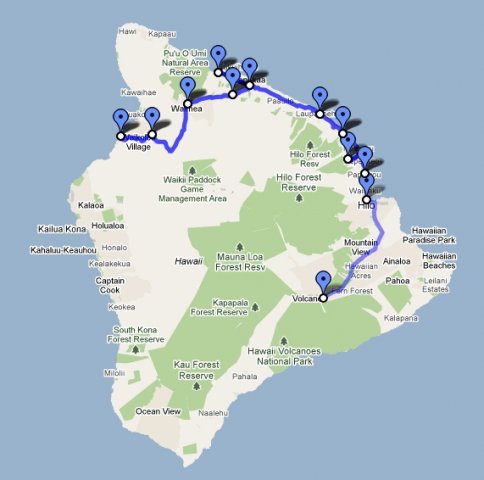
Click on the map for more detail. You will be able to zoom in and out, and move around.
Laupahoehoe Point was a seaside village, but in 1946, twenty-one children and three adults died in a tsunami, and the town was moved to higher ground.
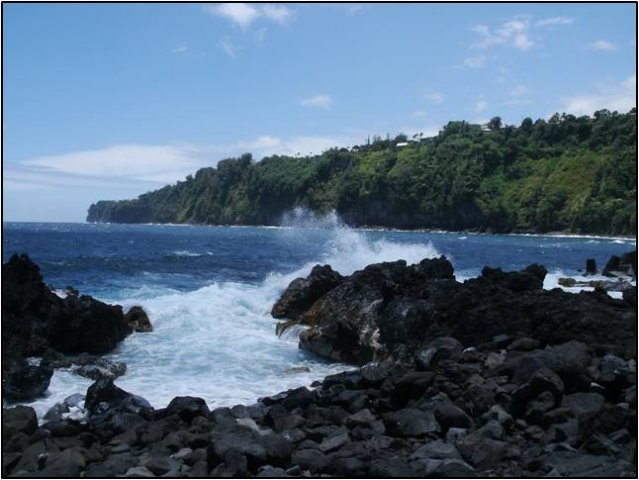
It is now a beautiful park, with a memorial and you-won’t-see-this-on-the-mainland warning signs.
I know you're all—one or two of you, anyway—waiting with bated breath for the next installment of the Hawaiian Adventure. I'm working on it. But it's not going to happen tonight, so instead you get a quick story of today's enjoyable shopping trip.
Yes. I did just use "enjoyable" and "shopping" in the same sentence.
Thirty-plus years ago we visited Brazil. One of the delights of foreign travel is the opportunity to expand one's taste in food, and that trip introduced us to, among other treasures, jabuticaba jelly, Antarctica Guaraná, and suco de maracujá sem açúcar. The last is passion fruit juice, without sugar, and was my staple breakfast drink every day I could get it.
It is hard to find passion fruit juice here, and when I do, it's always sweetened. Our local Albertsons did start stocking plain, frozen passion fruit purée a few years ago, so when, in my new-found enthusiasm for smoothies, I decided that passion fruit flavor was just what I needed, I turned to them.
Alas, they no longer carry it. But the willing-to-be-helpful clerk suggested we try a Bravo Supermarket. We have several nearby food stores, but Bravo is not one of them. Research, however, revealed one not far from our church, so this morning we ventured in.
Success! We came home with not one but three different brands of passion fruit purée: one from Colombia, one from Ecuador, and one from the Dominican Republic. Mmmm—smoothies tomorrow!
Finding a long-lost love is enough in itself to take the sting out of shopping, but Bravo did us one better by being such an interesting store. Even if it were closer, it wouldn't do for everyday use, because it's a small store with not much general selection. But it abounds in what I'd call, for lack of better information. Hispanic foods. The produce section was amazing, with half a dozen different kinds of bananas, and dozens of fruits and vegetables I know not of.
I look forward to other after-church excursions in the future.
Our concierge had informed us of Waikoloa Village Market, where the locals buy groceries, so yesterday we picked up a few supplies, such as SPF50 sunscreen, a pineapple, a knife with which to cut the pineapple, and breakfast materials. It was nice not to pay resort prices, but overall it must be admitted that Hawaii makes Swiss price tags seem reasonable. Lower-48 Americans can stop complaining about the cost of a fill-up now: gasoline is about a dollar more per gallon in Hawaii. We even paid more for the pineapple than we do at home in Florida.
We began our day with breakfast on the balcony: Raspberry Ginger Clusters & Flakes. It was good stuff, although the ginger overwhelmed the raspberry. Obliterated, really. Think of it as Blenheim-in-a-box.
The Hilton Waikoloa Village is a super resort. You could have a bank-breaking fabulous vacation without ever leaving the property. So, having spent but one night there, we left. We kept the room, for we intended to return the next day. (And we did.) But what care we for super resorts? We can have those for a lot less money without leaving Florida. Beaches, swimming, and snorkeling? Ditto. But volcanoes? Florida is remarkably short of that particular natural beauty. So we hopped in our rental car, and hit the road. (More)
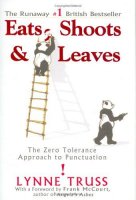 Eats, Shoots & Leaves: The Zero Tolerance Approach to Punctuation, by Lynne Truss (Gotham Books, New York, 2003)
Eats, Shoots & Leaves: The Zero Tolerance Approach to Punctuation, by Lynne Truss (Gotham Books, New York, 2003)
A panda walks into a café. He orders a sandwich, eats it, then draws a gun and fires two shots in the air.
“Why?” asks the confused waiter, as the panda makes towards the exit. The panda produces a badly punctuated wildlife manual and tosses it over his shoulder.
I’m a panda,” he says, at the door. “Look it up.”
The waiter turns to the relevant entry and, sure enough, finds an explanation.
“Panda. Large black-and-white bear-like mammal, native to China. Eats, shoots and leaves.”
Many thanks to DSTB for giving me this book, and thereby redeeming a past mistake on my part, made in response to a mistake on the part of our library.
I’d heard that Eats, Shoots & Leaves was a good book—though I knew little about it, as you will see—and so one day when I found it on tape at our library, I checked it out. I obviously was not paying attention when I put the cassette in our player, because apparently the wrong tape had been returned to the Eats, Shoots & Leaves packaging. What I heard was so uninteresting to me that I didn’t even finish the book, and don’t remember it now; it certainly wasn’t about punctuation.
“What?” you ask. “There’s something more boring than punctuation?”
Read Eats, Shoots & Leaves. You’ll never call punctuation boring again. You’ll laugh, and you’ll also learn.
One thing I learned is something I’ve suspected for a while now: the rules change when you cross the Atlantic. It’s not just the spelling (and pronunciation) of that metal out of which we make soda cans and “tin” foil. Truss encourages us to be sticklers for proper punctuation (hear, hear!)—a difficult enough task when bad examples surround us—but also cautions that sometimes what looks incorrect may be merely a cultural difference.
Be that as it may, the only thing that annoyed me about this short and pleasant book—and only as much as fingernails on a blackboard—was this British author’s persistent use of the British way of combining punctuation and quotation marks.
Many words require hyphens to avoid ambiguity: words such as “co-respondent”, “re-formed”, “re-mark”.
I would have called that plain wrong, but it turns out that putting the punctuation inside the quotation marks (<ahem> where it belongs!) is an Americanism.
Many words require hyphens to avoid ambiguity: words such as “co-respondent,” “re-formed,” “re-mark.”
I see the logic of the British system, but it still grates.
I also learned that there’s a reason for another annoyance ; this one is found in my beloved collection of George MacDonald books : What ? Colons, semicolons, question marks, and exclamation points ! find themselves preceded as well as followed by spaces. Truss provided the answer to my puzzlement: these books are facsimile editions, and that now strange punctuation procedure was at one time the Way Things Are Done.
Are you confused by the Way Things Are (or Should Be) Done Now? Check out Eats, Shoots & Leaves for some seriously amusing enlightenment.
A headline recently provided by my Google News feed illustrates the importance of correct punctuation.
Ratko Mladic arrested, Hillary Clinton in Pakistan
Imagine it now, without the comma:
Ratko Mladic arrested Hillary Clinton in Pakistan
Punctuation matters. So read, mark, learn, and inwardly digest—and enjoy!
Providence, Rhode Island.
My college roommate was from Providence. I drank an Awful Awful at the Newport Creamery on one visit, and worked for a day in a Brown University chemistry lab on another. I have pleasant memories of visits with her family, and of driving there from Boston, years later, when my brother's job took him to Providence one day and we met at an Indian restaurant for dinner. I've passed through T. F. Green airport countless times.
My allegiance to that New England city was cemented by the discovery that the founder of Providence, Roger Williams, is my tenth great-grandfather. He's Porter's ninth great-grandfather as well. So you might say Providence is in the family.
Thus I was thrilled to learn that the town charter of Providence, brought from England by Roger Williams himself in 1648, has been found, after some 140 years of "missing and presumed dead" status.
It was discovered by Paul R. Campbell, the city archivist, who "spends his days burrowing in the very attic of City Hall amid peeling paint, stacks of ponderous tomes and dusty boxes shielding secrets of the past, from the humdrum to the historic."
As he tells it, one recent Friday afternoon, a group came seeking certain records. As Campbell poked around material stored on a level above his office, he came across an open box. Inside sat a pocket folder from the 1960s, containing miscellaneous records of the now-defunct Providence Board of Aldermen.
But in the box there also reposed “a very old document, on vellum [animal skin],” he said. “I recognized right away the writing style of the 17th century — I did some research some years ago on 17th-century writing. It began to look like something more important than a deed. It was governmental in nature.”The signature of “John Warner, Clerk of the Assembly,” caught his eye. It dawned on him that here might be something momentous.
“I figured this was the John Warner, one of the early arrivals. The document, in a nutshell, is from when Williams came back from England in 1643 after he had obtained a charter from the king for the Colony of Rhode Island. He needed to get a charter for the Town of Providence, so he went to the Colonial Legislature of 1647-48, and asked for a town charter. This document is the town charter issued in March 1648. This is the Town of Providence creation document.”
What's in your attic?


